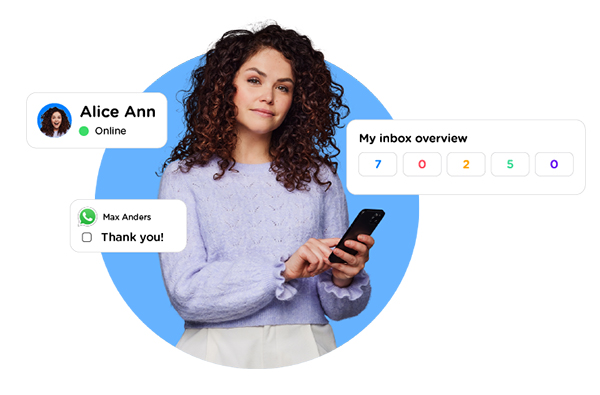- What Should Customer Service Teams Consider When Developing Their Tech Stack in 2023?
- 1. A Team Collaboration Tool
- 2. An Internal Knowledge Management Tool
- 3. A Knowledge Base Tool
- 4. An Omnichannel Customer Service Tool
- 5. A Customer Survey Tool
- Equip Your Customer Service Team With the Tech They Need to Deliver and Delight
Customer support tools are solutions that aid businesses in providing timely and effective customer service for customer satisfaction. Customer service departments need a solid set of tools in their tech stack if they are to delight customers—whether through providing self-help resources, automated quick services, or one-to-one assistance with a human touch.
As customer service trends evolve, the tools in your customer support tech stack need to help your business processes keep up with customers’ ever-changing support preferences.
What Should Customer Service Teams Consider When Developing Their Tech Stack in 2023?
Who are your customer service team helping? Customers, of course.
The tools in your customer support tech stack will thus need to facilitate a customer-centric business model—where your team’s top priority is resolving issues in a way that leaves customers satisfied with the service received.
Look for tools that help you to:
understand your customers, such as their order histories, and provide more relevant assistance,
support customers on channels they already use so they avoid the hassle of joining new channels to contact you,
render quick, efficient service through automated replies, where appropriate, and
foster collaboration and knowledge management among your team to ensure consistent and quality service, no matter who is attending to a customer’s needs.
Here are our shortlisted categories of customer support tools that achieve these aims:
1. A Team Collaboration Tool
Customer support representatives don’t work in silos. On any given day, they may be discussing how to handle certain customer queries with their teammates. They may also be sharing customer feedback with your product development and engineering teams and supporting the marketing team for ongoing marketing campaigns.
For effective collaboration among colleagues, customer service teams need a team collaboration tool that helps them get a bird’s eye view of team-wide goals and ongoing support conversations. By facilitating a system of open collaboration, the tool should also help support representatives chat with any customer, colleague, or external party—and vice versa—in one place.
Take our Mobile Service Cloud team collaboration tool, for instance. A customer may have contacted your customer service team about a limited-time offer they’d seen in a marketing email. Making use of Mobile Service Cloud’s integration with our Mobile Marketing Cloud tool, your support representative can review the specific marketing campaign the customer is referring to and advise them accordingly.
2. An Internal Knowledge Management Tool
Your customer support representatives need to have a thorough understanding of your offerings if they are to provide customers with the right answers. Some of this knowledge will become second nature as they familiarise themselves with your products and services. However, they may still need to refresh their memory on certain features from time to time.
You could leave your team to pass such knowledge down from one customer support representative to another. But when you do so, you risk having details forgotten or miscommunicated over time. Instead, it pays to store all product information in an internal knowledge management tool. An internal knowledge base chatbot for example.
Think of this tool as your team’s one-stop, self-help resource for product knowledge. If a support representative has a question about your products or services, they can fire up a chat with the internal knowledge management tool’s chatbot. The chatbot then retrieves the relevant information for your support representative on the spot. Just don’t forget to keep the information in your internal knowledge management tool up to date!
3. A Knowledge Base Tool
This is the customer-facing version of the internal knowledge management tool, where customers can browse articles, videos, and other resources that explain how your business’s products work. After referencing such material, they may be able to resolve certain issues on their own—thus saving themselves the time and effort of contacting support.
Compared to the internal knowledge management tool, which is geared toward helping internal teams understand your products or services, the information in your knowledge base tool should be written with customers in mind.
For example, your knowledge base resources may omit technicalities that customers don’t need to know about when using your product. You may also want to provide practical articles that educate customers on how to use product features (and get the most out of them).
P.S. Instead of getting customers to search for information themselves, why not let a chatbot share it with them right away? That’s where our next recommended tool will come in handy.
4. An Omnichannel Customer Service Tool
If customers need to contact support, an omnichannel customer service tool makes doing so easy. It integrates with multiple support channels, enabling customers to reach out via their preferred channel and get the help they seek.
As the first layer of service, the omnichannel customer service tool can offer automated and immediate chatbot replies to requests that don’t require human assistance. For instance, a customer may start a chat with the tool’s scripted chatbot to ask about their e-commerce order’s delivery status. The tool can then pull up the relevant information from your business’s database and share it with the customer.
Where a customer’s query is more complex and calls for human support, the omnichannel customer service tool can assign the conversation to a support representative. Regardless of its channel of origin, the conversation will be displayed in a central Agent Inbox for your team’s convenient reference and action. Especially powerful omnichannel customer service tools will also be integrable with marketing tools, such as Mobile Marketing Cloud, to feature a customer’s profile and order history next to their support conversation.
Such features came in handy for synthetic pottery retailer Elho, which used the Mobile Service Cloud omnichannel customer service tool to cater to its customers’ diverse support channel preferences.

Gone were the days of its support representatives having to open multiple tabs for various support channels. Instead, they could now view all conversations in a single window. Elho’s representatives could also view a customer’s recent orders and website activity on the same page as the support conversation, enriching the quality of the support delivered.
After adding Mobile Service Cloud to its customer support tech stack, Elho attained a Net Promoter Score of 62.3, which is higher than the minimum score of 50 to be considered an excellent rating.
5. A Customer Survey Tool
How satisfied are customers with the support experience? This is vital feedback that can help you improve the quality of assistance you provide in future support matters.
To get such information, you’ll need to ask customers—and a customer survey tool can automate this process at scale. Design your survey in the customer survey tool, then set it up to email your customer after the issue has been resolved.
In the email, seek your customers’ thoughts on their recent support conversation with you and provide a first survey question. When customers click the question to respond, they’ll be directed to the full survey for sharing more comprehensive feedback.
The customer survey tool can also aggregate the feedback received, letting you identify trends and any areas of improvement. For example, if customers consistently praise the speed of support received, then you know this is something worth keeping up with!
Equip Your Customer Service Team With the Tech They Need to Deliver and Delight
The customer support journey spans many stages, from the customer browsing self-help resources to interacting with the customer support team, and finally to providing feedback once the matter has been closed.
A robust customer support tech stack will equip your customer service team with the ability to delight customers at all these stages, even if customers never end up speaking with a support representative. But if they do, your chosen tools should help your customer service team provide a smooth and VIP customer experience that takes a support interaction from merely “Good” to “Phenomenal!” in 2023.

Mobile Service Cloud is one such tool, where customers can enjoy instant assistance with simple requests using a built-in chatbot. Alternatively, if customers wish to chat with a representative, Mobile Service Cloud will seamlessly connect them with one.
With an integration to a marketing tool like Mobile Marketing Cloud, your representatives can view customer profiles directly within Mobile Service Cloud and provide more personalised assistance based on your customer’s past interactions with your business. All such support conversations also occur via the customer’s channel of choice, facilitating a frictionless support experience.
Explore Mobile Service Cloud here to learn how it can enhance your support processes and complement the other tools in your customer support tech stack.
